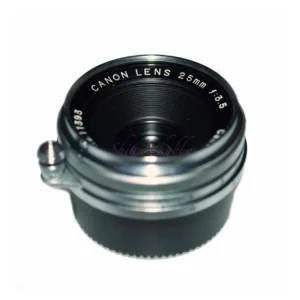CANON S 25mm F3.5(L39)

A review and sample photos of the L39 screw mount CANON S 25mm F3.5 used with the LEICA M6 and FUJIFILM 4002.
- Please see the disclaimer regarding advertising here.
- Italicized links in the text are advertisement links that take you to other sites.
Table of contents

Gallery
The sample photos were taken using a LEICA M6 + FUJIFILM 400.
Review

1.Overview
The CANON S 25mm f/3.5 is a standard lens with an L39 screw mount, released by Canon in 1956 for their Barnack Leica-compatible cameras. Canon refers to it as the S-mount, taking the initials of the screw.
The lens construction is called the Topogon type, a symmetrical lens arrangement with a flat glass element added to the last group.
The main specifications are as follows, with details provided in the table.
- Aperture: 3.5
- Lens Construction: 5 Elements in 5 Groups
- Aperture Blades: 6
- Minimum Focus: 1.0m
Leica M Rangefinder Camera Rangefinder Coupling: 1.0m
The lens construction diagram can be found at the Canon Museum and in the book “Leica Lenses of the World” (p. 120). While the book lists the lens construction as 3 groups and 5 elements, based on the Canon Museum’s description and diagram, all lens elements appear to be independent, so we believe the correct number is 5 groups and 5 elements.
2.Usability
I only used the Canon S 25mm f/3.5 with a film camera, so the results with a digital camera are not relevant. Looking at the results with the film camera, I stopped down to around f/5.6, so there was almost no distortion in the corners or vignetting, and the colors were accurately reproduced with color negative film.
The only rangefinder cameras that use the 25mm focal length are the Voigtlander BESSA R4A/R4M, which features a wide-angle viewfinder, and the LEICA M8, a digital camera with an APS-H sensor size smaller than 35mm. Other cameras do not have a viewfinder frame, so an external viewfinder is required.
With a film camera, the wide-angle 25mm lens allows you to set it to around f/8 and, with the focus lever set to around 2m, shoot with a focus that’s generally in focus at distances farther than 1m. This method allows you to focus solely on composition while looking through the 25mm external viewfinder.
External viewfinders such as the LEICA 24mm, Voigtlander 25mm, and CARL ZEISS 25mm finders are easy to obtain, and the newer the finder, the better the visibility.
After purchasing and using all of them, I found the CARL ZEISS 25mm external viewfinder to provide the clearest view.
Also, if you’re looking at the approximate view of a film camera, a camera with a 28mm viewfinder frame can capture the full extent of what’s visible, equivalent to 24-25mm. This depends on the camera, so you’ll just have to remember the area you looked through and compare it with the results to see if it’s usable.
Film cameras can be used without much hassle as described above, but with digital cameras, when you enlarge the results on a monitor, even pan focus can sometimes make everything outside the focal point appear blurry, so it’s best to focus precisely in the viewfinder. Composing a digital shot is relatively easy, so it’s fine to just shoot while looking at the 28mm viewfinder frame.
3.Summary
In conclusion, to sum up the CANON S 25mm F3.5, although it is an old lens, it is still perfectly usable with film cameras thanks to its symmetrical construction which results in little distortion and the ability to resolve when stopped down.
As for digital cameras, there is a possibility of noticeable vignetting and color cast, so it is best to test it out before deciding to purchase.
Specifications, considerations, etc.
The 25mm focal length is now a relatively common focal length, often found at the wide-angle end of zoom lenses. Prior to that, it was typically found in prime lenses or wide-angle zoom lenses.
It’s a bit of a tricky focal length, wider than 28mm but narrower than 21mm. When I primarily used rangefinder cameras, I used lenses like the LEICA ELMARIT M 24mm ASPH., CARL ZEISS BIOGON 25mm ZM, and Snapshot Skopar 25mm.
Since both 24mm and 25mm are tricky focal lengths, I would attach different lenses to my camera and shoot accordingly, but I never encountered a situation where I needed a 24mm or 25mm.
Consider combining them with other lenses, such as a wide-angle trifocal set of 18mm, 24mm, and 35mm, or a balanced set of 25mm, 50mm, and 75mm for a wide-angle to telephoto feel. Considering whether to get a 24mm or 25mm lens depends on the lenses you already own.
| Item | CANON S | Snap Shot Skopar |
| focal length(mm) | 25 | 25 |
| Maximum aperture | 3.5 | 4 |
| Minimum aperture | 22 | 22 |
| Aperture blade | 6 | 10 |
| Lens configuration | 5 elements in 5 groups | 7 elements in 5 groups |
| Minimum distance(m) | 1 | 0.7 (distance meter not linked) |
| Lens length(mm) | 15 | 29.5(L39) |
| Lens max diameter(mm) | 48 | 49.5 |
| Filter diameter(mm) | 40 | 39 |
| Weight(g) | 145 | 90 |
| Hood | ? | LH-1 |
| Lens mount | L39 | VL(L39) |
| Release date | 1956 | 1999.2 |
| Price | ¥32,500 | 45,000(silver)/45,000(black) |
Reference links
- Canon Museum 25mm F3.5
- Leica Lenses of the World (P120) / CANON 25mm F3.5・Ads by Amazon
- Snap Shot Skopar 25mm F4 ・Shige’s hobby
Affiliate links
- Canon lens・Ads by Amazon
- Old Canon Books・Ads by Amazon
- Leica Lenses of the World (P120) / CANON 25mm F3.5・Ads by Amazon

Update history
- 2025.9.11
Leave a Reply